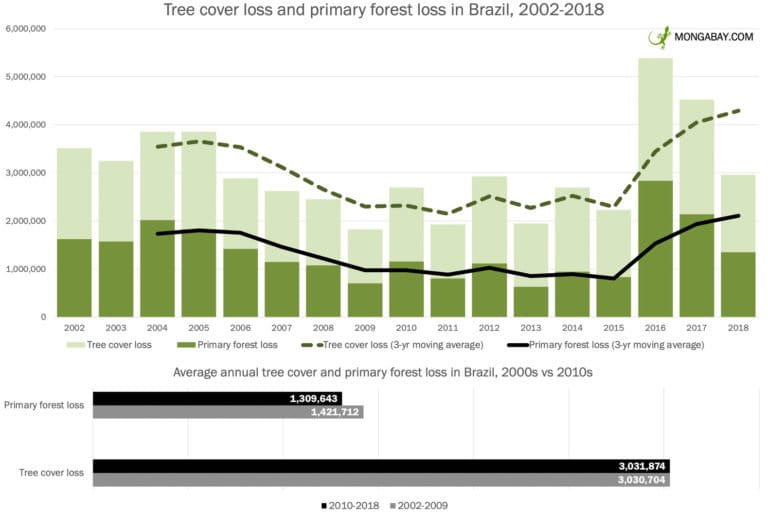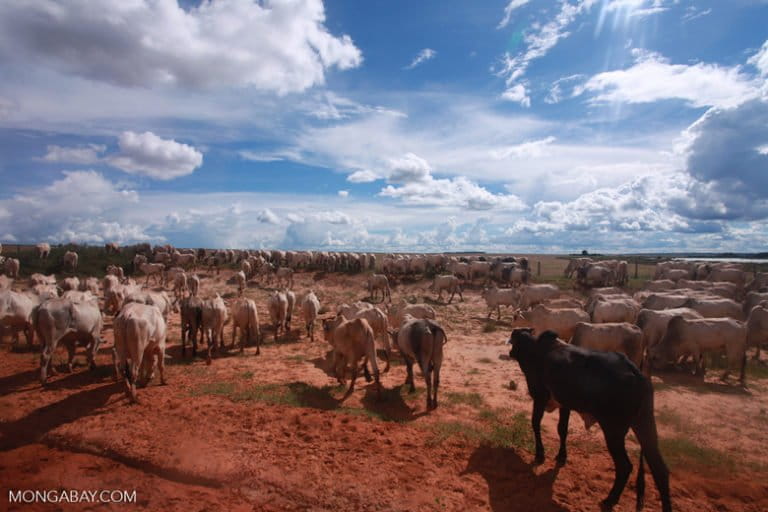- Human activity is already threatening 80% of the world’s forests with destruction or degradation. Deforestation is also putting ecosystems and 50% of the world’s biodiversity at risk, along with forest peoples.
- Atop that, dense intact tropical forests serve as vital carbon sinks. But forest loss accounted for 8% of the world’s annual CO2 emissions in 2018, while intact tropical forest loss from 2000 to 2013 will result in over 626% more long-term carbon emissions through 2050 than previously thought, according to new research.
- Zooming in on just one example, 17% of the Amazon has been cleared at one time or another. Another 20% has been degraded. In 2019, the deforestation rate there shot up 30% from the year before. The risk is that climate change combined with deforestation could lead to an Amazon forest collapse, with huge releases of carbon.
- If tropical nations, and nations consuming forest products, but had the political will, then the world’s forests could be conserved. One approach: create buffers around intact tropical forests by reducing road networks while reforesting. Also, give indigenous groups more power to protect forests, as they’re proven to be the best stewards.

Across the tropics, flames rip through forests, chainsaws tear down ancient trees, while elite farmers and ranchers make a grab for more land belonging to the public or to indigenous people — a land-hunger fed by commodities trading giants and global investors in pursuit of ever higher profits gained from international markets in the EU, China, the U.S. and elsewhere.
In tropical regions today, human activity already threatens 80% of forests with degradation and destruction, while ongoing loss of tropical forests has a devastating impact on rural forest-dwelling peoples and on ecosystems that support 50% of the world’s biodiversity.
Representatives meeting this month from countries around the world in Madrid, Spain for the 25th United Nations Climate Change conference (COP 25) did nothing to help matters, stonewalling virtually all measures to conserve tropical forests. Meanwhile, a clearer picture is emerging as to the effects of tropical deforestation will have in the near future on our planet’s climate — looming consequences appear far bleaker than previously thought.

A darkening prospect for intact forests
The Wildlife Conservation Society (WCS) recently published a study in the journal Science Advances suggesting intact tropical forest loss from 2000 to 2013 will result in over 626% more long-term carbon emissions through 2050 than previously thought. The researchers arrived at this upward revision by adding up emissions that would have been removed from the air if tropical forest remained intact, from selective logging, defaunation, and carbon stock degradation at forest edges that had been overlooked in previous studies.
Study co-author Tom Evans told Mongabay that forest conservation was recognized as critical for mitigation and adaptation to climate change in the 2015 Paris Climate Agreement. However, despite that initial commitment, he noted that not enough attention has been given since to protection of intact forests for climate change mitigation.
“We knew that large forest blocks should be getting a great deal of attention for their role in climate change mitigation and adaptation, but we saw that wasn’t happening, with most programs focused on frontier forests,” Evans said. “We took a look at carbon emission estimates from previous studies to clarify why these [intact forest] areas are as important [to curbing climate change] as they are.
Dense intact tropical forests serve as vital carbon sinks, removing carbon dioxide from the atmosphere as their carbon-hungry plants and trees continue to put on growth. And they serve an outsized role in sequestration: while the WCS study found only 20% of the world’s tropical forests can be considered “intact,” these forests store 40% of aboveground carbon found in tropical forests. A 2011 study observed that intact tropical forests remove an estimated 1 billion metric tons of carbon dioxide from the atmosphere each year.
“The value of intact forests becomes clearer [as] we count toward the long-term 2050 milestone when humanity should be transitioned from net emissions to net sequestration,” Evans said. “Without keeping our intact forests, it will be impossible to implement our climate goals outlined in the Paris Agreement.”
But intact forests can’t sequester carbon if they’re felled. There were 549 million hectares (2.1 million square miles) of intact tropical forest remaining globally at the end of 2013, but that was down by 49 million hectares (189,000 square miles) compared to 2000.
And of course, since then ranchers, farmers, loggers, miners, dam and road builders, along with those participating in a myriad of other industrial activities, have degraded and cleared away more intact forests, and in many places at an increasing rate — removing opportunities for countries to capitalize on forest carbon sinks to counteract the climate crisis.

Future forest carbon sequestration losses
And there’s more bad news: not all the carbon losses caused by intact forest loss have happened yet, Evans explained, but rather are predicted to emerge over the coming decades because new, expanded forest edges cause degradation and residual carbon losses over time. Carbon storage loss is caused both by direct human activity and by passive edge effects associated with forest fragmentation.
“When near forest edges are created, there’s the problem of increased human access with grazing animals and fires from farmland penetrating the forests that causes increased degradation and deforestation,” Evans said. “But even more than that, just by creating the edge, the cooler, dark, humid understory ecosystem is replaced with a hotter, drier environment that causes carbon stocks to decrease as large, dense trees are replaced by smaller, less dense ones.”
Evans noted that there are three remaining major blocks of intact tropical forest globally — the Amazon basin, Central Africa, and Papua New Guinea — plus smaller blocks in Southeast Asia, Central America and Madagascar, among others. Although there are higher proportional losses elsewhere, in absolute terms, he said the largest disappearance of tropical forest has taken place in the Amazon basin — mostly taken up by Brazil, a region worth a closer look.

The Amazon example: future carbon sink or source?
Carlos Nobre, a leading expert on the Amazon rainforest and climate change, agrees with the WCS assessment, emphasizing that the conservation of “all tropical forests” is key to addressing climate change because of the important role they play in removing carbon dioxide from the atmosphere.
Studies since the 1980s have repeatedly shown that the Amazon, the world’s largest block of intact rainforest, has served as a significant carbon sink, sequestering over 5% of human-caused carbon emissions annually. Nobre warned, however, that the latest research suggests that the rainforest’s ability to absorb carbon may have already started to decline.
“In some years, the Amazon removed up to two billion tons of CO2 from the atmosphere. That was something like 6 to 8 percent of global emissions at the time,” Nobre said. “But in the last few years, there have been several studies showing the Amazon is not as strong of a sink as before.”
Nobre pointed to a potential cause: recent record-breaking Amazon droughts that have tremendously increased tree mortality. In particular, and alarmingly, he said, newer studies suggest that the southeast Amazon may no longer be serving as a carbon sink, but rather as a source, adding to global greenhouse gas emissions.
“Widespread forest degradation and deforestation in the southeast Amazon region reduces the resilience of the forest to fires and drought. When you start degrading and fragmenting the forest, you have more solar radiation hitting the forest floor; the plants dry out and the entire forest becomes more flammable and carbon losses increase,” Nobre said.

Already, 17% of the Amazon has been clear cut at one time or another to make way for cattle ranching and crop lands. Another 20% of remaining forest, according to Nobre, has been degraded and is at a high risk of deforestation. In 2019, the rate of deforestation shot up 30% from the year before, he added, tree loss driven by Brazilian President Jair Bolsonaro whose administration has implemented what Nobre calls a “deforestation-based model of development.”
In addition to human-caused deforestation and degradation, global warming itself is decreasing the Amazon forest’s ability to store carbon in organic matter, particularly in soils. Soil carbon is decreasing in “undisturbed” Amazon rainforest plots measured near Manaus, Brazil, according to a study done by Brazil’s National Institute for Research in Amazonia state (INPA). Researchers warn that the “release of soil carbon can contribute to a positive feedback, where emissions cause greater warming that further augments the emissions.” Put simply, human-caused climate change is causing nature as we know it to change, increasing carbon releases in multiple ways.
The court is still out, and there is a continuing debate in the scientific community over what the long-term effects of rapidly rising atmospheric CO2 concentrations will be on forests, especially their ability to act as carbon sinks or sources in the future. Research published in Biogeosciences, for example, found that as atmospheric carbon concentrations increase, tropical forests are growing faster and taking more CO2 out of the air. But a potentially contradictory study published last January in Nature, suggested forest plants and soils may start to absorb less carbon if the climate heats up past a certain tipping point.

Forest loss adds to surging global carbon emissions
According to a new comprehensive report, the Global Carbon Budget 2019, published during COP25 this month, global carbon emissions are set to hit record levels this year. The report projects 0.6% growth in CO2 emissions in 2019, reaching 37 billion tons per year for the first time in recorded history.
While a sharp drop in coal-based energy production in the United States, and slower growth in China and India, helped slow the rate of emission growth from earlier years, increasing use of natural gas and oil kept CO2 concentrations in the atmosphere headed steadily upward.
An earlier analysis by Global Forest Watch found tropical forest loss accounted for 8% of the world’s annual CO2 emissions in 2018. Putting this in perspective as to magnitude, if tropical forest loss were a country, the resulting emissions from all that clear cutting would rank just below the U.S. and significantly higher than the EU in terms of contribution to global warming.
Meanwhile, in November, the UN Environment Programme (UNEP) issued its Emissions Gap Report, and warned that unless global greenhouse gas emissions fall by 7.6% each year between 2020 and 2030, the world will fail to reach the Paris agreement’s goal to limit global warming to 1.5 degrees Celsius — potentially leading to catastrophic climate change.
John Christensen, who was on the UNEP report’s project steering committee, noted that while wind and solar have become economically competitive sources of electricity, challenges remain when it comes to implementing a decentralized power system. So healthy forests will definitely be needed to help store emissions.
“When looking back at the 10 years we have prepared the Emissions Gap Report, it is very disturbing that in spite of the many warnings, global emissions have continued to increase and do not seem to be likely to peak anytime soon,” Christensen said. Increasingly, forest loss is becoming a source, not a sink, for those growing emissions.

What can be done to address tropical rainforest loss?
While there are isolated success stories when it comes to stopping, or at least slowing, tropical forest loss, Evans made it clear that by and large most countries “are not yet winning the battle.” However, he said there are ideas that hold promise — if nations develop the political will to quickly implement them.
For instance, he suggested creating buffers around intact tropical forests by reducing road networks in forest areas, while reforesting and reintroducing natural fauna to reverse damaging edge effects. He suggested implementing agroforestry techniques to support local livelihoods while also pushing forest edges outward and away from intact forests.
“Intact tropical forest is not binary. If you create buffers around primary forests, so the edge is no longer an edge, the edge process can go into reverse, with large trees more likely to survive and forests becoming more humid and darker again,” sequestering more carbon, Evans said.
In the Brazilian Amazon, Nobre suggested that a marked reduction in deforestation would require the government to quickly adopt policies resembling those utilized between 2005 and 2014 when indigenous environmental leaders were more empowered, and authorities aggressively targeted organized environmental crime by putting criminals in jail and destroying their mining and logging equipment, including chainsaws and earthmovers. However, at present under Bolsonaro, arrests and fines for environmental crimes are far fewer, and officials are no longer allowed to destroy illegally deployed equipment.
As a result, Nobre welcomed international pressure by consumers and the European Union who have threatened to boycott Brazilian agricultural products unless deforestation in the Amazon is properly addressed.
Pointing to research that showed only 2 to 3 percent of indigenous territory has been deforested, compared to 5 to 6 percent of other legally protected areas, Nobre said it is critical that governments and international efforts support the Amazon’s indigenous people in their existential fight against forest degradation and deforestation.
“Because the indigenous communities have a forest culture, a religious element to their struggle against deforestation, they are perhaps the most dedicated defenders against land grabbing and environmental destruction,” Nobre concluded. “It’s very important to support indigenous communities to slow, or stop, deforestation in the Amazon.”
Banner image caption: Intact rainforest in Sulawesi, Indonesia. Image by Rhett A. Butler / Mongabay.
FEEDBACK: Use this form to send a message to the author of this post. If you want to post a public comment, you can do that at the bottom of the page.
